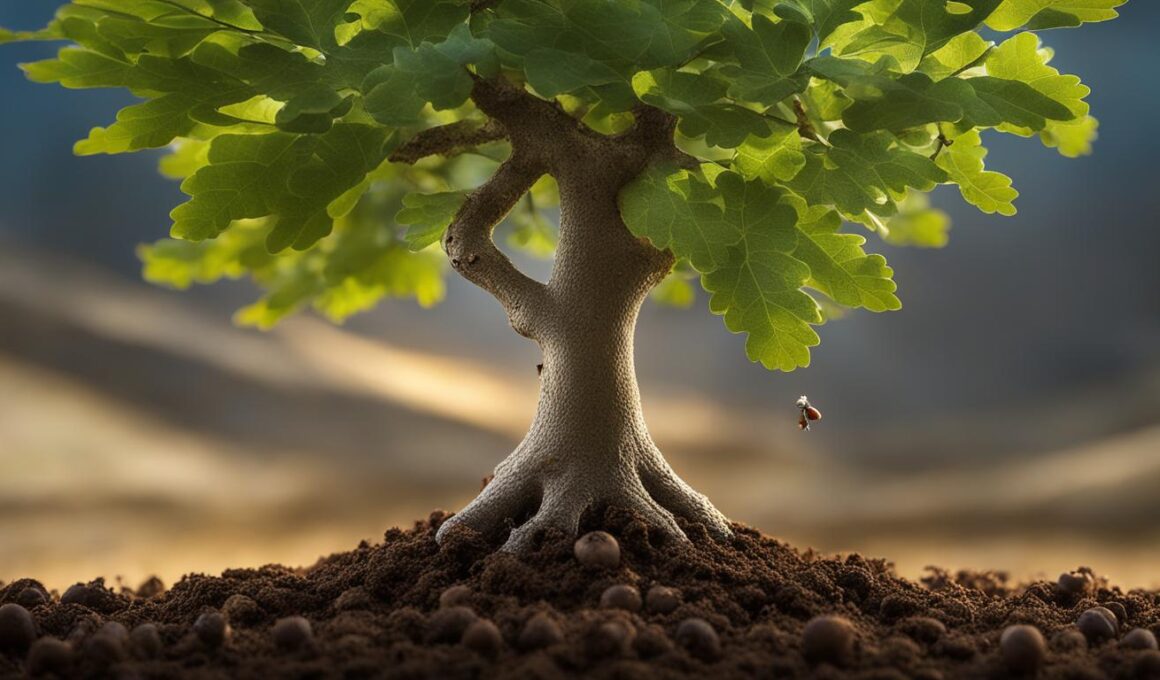Acorns, those small and mighty nuts, are often associated with the term “acorn tree.” However, the reality is that acorns are not produced by a specific type of tree called the “acorn tree.” Instead, acorns are formed on various species of Oak trees, making the term “acorn tree” a misnomer.
Oak trees are renowned for their longevity and their vital role in maintaining the balance of ecosystems. Acorns, their distinctive fruit, play a crucial part in this delicate web of life. They serve as a valuable source of nutrition for countless wildlife species, including birds, squirrels, and other small mammals, contributing to the biodiversity of our surroundings.
With hundreds of Oak tree species worldwide, each variety produces its own type of acorn. From the majestic White Oak Tree to the robust Chestnut Oak, the Post Oak Tree to the resilient Blackjack Oak, and the imposing Black Oak Tree, the diversity of Oak trees is truly awe-inspiring. Each unique acorn tells a story of its tree’s characteristics and adaptations.
If you are intrigued by the thought of growing an Oak tree from an acorn, continue reading to discover the fascinating process and steps involved. You’ll learn about the types of acorns and Oak trees, the cycles of acorn production, and the rewarding journey of nurturing an acorn into a flourishing tree.
Let’s explore the world of Oak trees and their incredible acorns together!
Types of Acorns and Oak Trees
When it comes to acorns, different oak tree species produce unique variations that are crucial for proper tree identification. Let’s explore some of the most common acorn types and the oak trees they come from.
White Oak Tree Acorns
White Oak Tree acorns have a distinct appearance that sets them apart. The cap of a White Oak acorn covers only about one-third of the nut, giving it a distinctive look. This type of acorn is an essential food source for many wildlife species.
Chestnut Oak Acorns
Chestnut Oak acorns mirror the rough bark of the adult trees and have a bumpy and warty cup that covers about half of the nut. These acorns provide valuable nutrition for various animals and contribute to the overall health of the ecosystem.
Post Oak Tree Acorns
Post Oak Tree acorns are longer than those of other oak tree species. They have a flat top cup that covers about one-third of the nut. This type of acorn plays an important role in the natural food chain and is eagerly sought after by many animals.
Blackjack Oak Acorns
Blackjack Oak acorns share similarities with Post Oak acorns. However, they have a distinctive bowl-shaped cap with scales, covering about half of the nut. These acorns support a diverse range of wildlife and contribute to the overall biodiversity of their surroundings.
Black Oak Tree Acorns
Black Oak Tree acorns are easily recognizable due to their large rounded top and cap that covers half of the nut. They provide nourishment to many species of birds, mammals, and insects, ensuring a healthy balance in the ecosystem.
Identifying different oak tree species based on their acorns is crucial for understanding the ecosystem and the role these trees play in supporting wildlife. By recognizing the unique characteristics of each acorn type, you can gain a deeper appreciation for the diversity within the oak tree family.
Acorn Production and Oak Tree Cycles
Oak trees have a fascinating reproductive cycle that determines the production of acorns. Unlike some trees that bear fruit annually, oak trees do not produce acorns every year. Instead, most oak tree species follow a cycle where they produce acorns every 2 to 3 years, although some specific trees may produce them annually.
It’s interesting to note that different oak tree species have varying acorn production patterns. For example, white oak trees have a longer production cycle, with acorns being produced once every 4 to 6 years. On the other hand, red oak trees have a slightly shorter cycle, typically producing acorns every 3 to 5 years.
The production of acorns is influenced by several factors, including the age of the oak tree. Young oak trees may take several years before they start producing acorns, while older, mature trees are more likely to bear fruit. Additionally, environmental factors can affect acorn production, with certain years known as “mast years” characterized by high acorn production.
Mast years occur every 2 to 5 years and are part of the oak tree’s natural reproductive strategy. During these mast years, oak trees produce an abundance of acorns, ensuring the survival and propagation of the species. The timing of acorn fall varies slightly depending on the specific oak tree species, but it typically occurs between August and October.
To visualize the cycle of acorn production in oak trees, take a look at the image below:
This image provides a visual representation of the various stages of acorn production and the fall cycle in oak trees.
Growing Oak Trees from Acorns and Conclusion
Growing an oak tree from an acorn can be a rewarding and fulfilling experience. To begin, carefully select viable acorns that are intact and undamaged. Soak the chosen acorns in cold water for 24 hours to stimulate germination. Remember to discard any acorns that float or show signs of damage.
Once soaked, you can choose to plant the acorns either in pots or directly into the ground. Ensure that the soil is kept consistently moist throughout the growing process, especially during the crucial germination period. Protect the young seedlings from excessive heat or cold temperatures and provide adequate shade.
After germination occurs, thin out the seedlings and select the strongest acorn for continued growth. This allows the chosen oak sapling to receive the necessary nutrients and resources to thrive. As the seedling grows, consider transplanting it into larger pots to encourage further root development.
Eventually, the oak sapling will outgrow its pot and require transplantation to a permanent location such as a garden or outdoor area. Prepare the new site with well-drained soil and make sure it receives adequate sunlight. Remember to continue monitoring soil moisture and provide regular care for the young oak tree as it matures.
Is it Normal for Lemon Trees to Drop Their Leaves?
Yes, it is normal for lemon trees losing leaves, especially during the winter months. Lemon trees often go through a period of leaf drop as they adjust to changes in temperature and light. Providing proper care and maintaining a consistent environment can help minimize leaf loss.










